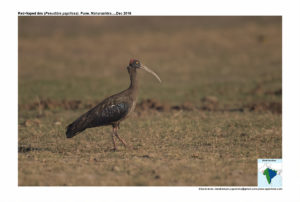Red-naped-lbis

Red-naped Ibis Pseudibis papillosa
Etymology:
- Pseudibis : Greek word pseudos- false; ibis-
- Papillosa : Latin word for Pimple ( the red cap on the head of the ibis is like a pimple)
Vernacular names: Hindi: Baza, Kala baza, Karan kul, Sans: Krishna aati, Pun: Kala buza, Ben: Kalo dochara, Ass: Kola akohi bog, Guj: Kali kankanasar, Mar: Kala sherati, Ta: Karuppu aruval mookan, Te: Nalla kankanam, Mal: Chemthalayan ibis
Distribution in India: Wide spread resident and winter visitor in India other than Himalayas.
Description:Size of 80-90 cm. It is a large black bird with long legs and a long down curved bill. The wing feathers and tail are black with blue-green gloss while the neck and body are brown and without gloss. A white patch on the shoulders stands out and the top of the featherless head is a patch of bright red warty skin. The warty patch is a triangular patch with the apex at the crown and the base of the triangle behind the nape that develops in adult birds. The iris is orange red. Both sexes are identical and young birds are browner and initially lack the bare head and crown. The bills and legs are grey but turn reddish during the breeding season. The toes have a fringing membrane and are slightly webbed at the base. The immature is generally dull matt brown; has feathered head.
Habitat: It is found in dry grassy areas, meadows, cultivated or fallow land and fields of stubble, often far from wetlands; also sandy banks of rivers and swamps. It nests in tall trees.
Food Habits: It is entirely dependent on microscopic blue green algae and diatoms; to lesser extent small invertebrates which may partially substitute normal food in times of very low Spirulina densities. Usually feeds near surface in calm water, with bill only partly submerged; walks or very often swims, which is only way of reaching fair proportion of potential food supply in most lakes.
Breeding Habits: They breed in March-May in India. They are solitary nesters. The nest is a large platform of twigs, lined with straw, built on palm tree or other leafy tree; often takes over disused nests of raptors. They lay a clutch of 2–3 eggs. The incubation period is 25–27 days.